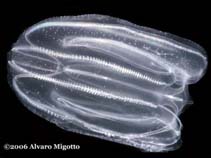Mnemiopsis leidyi Agassiz, 1865
Warty comb jelly| Native range | All suitable habitat | Point map | Year 2050 |

|
| This map was computer-generated and has not yet been reviewed. |
| Mnemiopsis leidyi AquaMaps Data sources: GBIF OBIS |
Classification / Names Common names | Synonyms | CoL | ITIS | WoRMS
Tentaculata | Lobata | Bolinopsidae
Environment: milieu / climate zone / depth range / distribution range Ecology
Pelagic; depth range 5 - 200 m (Ref. 1531). Subtropical; 1°C - 32°C (Ref. 2982); 40°N - 46°S, 98°W - 31°W
Distribution Countries | FAO areas | Ecosystems | Occurrences | Introductions
Asia-Inland Water, Atlantic Ocean and the Mediterranean.
Length at first maturity / Size / Weight / Age
Maturity: Lm ? range ? - ? cm Max length : 18.0 cm TL male/unsexed; (Ref. 114265); common length : 1.0 cm TL male/unsexed; (Ref. 3033); max. published weight: 0.97 g (Ref. 3033)
Short description Morphology
Life cycle and mating behavior Maturity | Reproduction | Spawning | Eggs | Fecundity | Larvae
Main reference
References | Coordinator | Collaborators
Mutlu, E. 1999 Distribution and abundance of ctenophores and their zooplankton food in theBlack Sea. II. Mnemiopsis leidyi. Mar. Biol. 135:603-613. (Ref. 1531)
IUCN Red List Status
(Ref. 130435: Version 2025-1)
CITES status (Ref. 108899)
CMS (Ref. 116361)
Threat to humans
Human uses
| FishSource |
Tools
More information
Max. ages / sizes
Length-weight rel.
Length-length rel.
Length-frequencies
Mass conversion
Abundance
Internet sources
BHL | BOLD Systems | CISTI | DiscoverLife | FAO(Publication : search) | Fishipedia | GenBank (genome, nucleotide) | GloBI | Gomexsi | Google Books | Google Scholar | Google | PubMed | Tree of Life | Wikipedia (Go, Search) | Zoological Record



